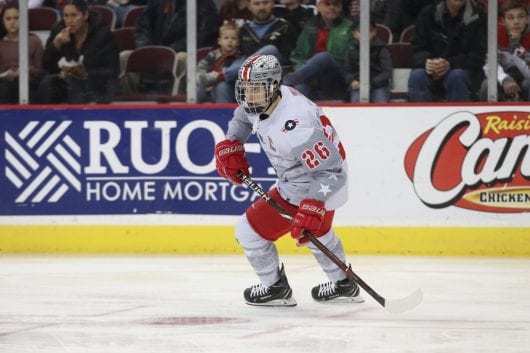
Ohio State senior forward Mason Jobst (26) looks down the ice in the game against Minnesota on Feb. 15. Ohio State lost 4-3. Credit: Nick Hudak | For The Lantern
The Jobst family was not known for its talent on the ice.
One uncle played some adult hockey, and the family members were Chicago Blackhawks’ fans who played pond hockey from time to time, but no one had played in a professional setting.
Because of his aunt, Mason Jobst wanted to change that.
Alissa Prather, called Aunt Sissy by Jobst, bought him a hockey stick and ball when he was 18 months old.
The quality of the stick was low: a plastic, blue-and-yellow stick that was bought at Toys R Us. But to Jobst, the stick was everything.
When he was a toddler, Jobst woke up from a nap while his mom was still asleep and his dad was at work. With his beloved hockey stick and the Blackhawks on his mind, Jobst emptied a large tub of baby powder onto the hardwood floors throughout his house, creating a white surface that resembled an ice rink.
“He said, ‘Look Mom! I made a skating rink!’ and he had socks and a diaper on and was skating around the house, hitting with a stick and a puck,” John Jobst, Mason Jobst’s father, said. “We got the video camera out, and he was like showing me what he’d done, and he’d bounce himself into the walls acting like he was being checked.”
The gift from his aunt and a pair of Size 2 hockey skates his mother bought him from Play It Again Sports changed Jobst’s life forever.
Before becoming a second-team All Big Ten member, a captain for a Frozen Four team and the highest scorer for Ohio State in 30 years, senior forward Mason Jobst was just a kid who didn’t want to take his skates off.
In his final season for the Buckeyes, Jobst is the active collegiate leader with 164 career points in his four seasons with Ohio State, the 13th-most points in school history.
Before making his way to Columbus, Jobst went to Muskegon, Michigan, to play for the Lumberjacks in the United States Hockey League. On the surface, Jobst finished with 88 points in 155 games and did enough to earn a scholarship at Ohio State.
But his time at Muskegon wasn’t that easy. In his second year with the Lumberjacks, Jobst tore the labrums in his left and right shoulders, both of which required surgery.
The strategy for the surgeries and recoveries was simple: a procedure on one shoulder each year for the next two offseasons.
This was not as easy as Jobst hoped.
After fixing his left shoulder during the first offseason, Jobst was unable to work out while the season approached, leaving him at around 140 pounds.
Jobst’s second season was his hardest for Muskegon, playing despite his right shoulder popping out of place every game.
Despite being named a team captain the next season, Jobst didn’t read too much into the title.
“I’d been in the league for so long that it was like, who else were they gonna pick at that point?” Jobst said.
The following offseason, Jobst had the surgery on his right shoulder, which the doctor promised would be his last, John Jobst said.
After a 45-point season in 49 games, his best season with the Lumberjacks, the stitches came out, and a third surgery — the second on his left shoulder — was required, forcing the then-20-year-old to miss the majority of another season.
“It was a pretty dark time in my life. Hockey had been taken away from me for so long,” Jobst said. “It really sucked.”
During his time with the Lumberjacks, Jobst did not receive many Division I offers.
His dream of playing at a Big Ten school nearly got him to walk on at Penn State, but without the money to do so, Jobst waited, eventually committing to the Buckeyes over Nebraska Omaha and Western Michigan.
“Through juniors he had three shoulder surgeries that made me think that he was about done,” John Jobst said. “I didn’t think he could make it through four years of college and … miss a game because of injury. It’s pretty amazing.”
Hardships did not end for Jobst when he came to Ohio State. The Buckeyes lost their first seven games to start the 2015-16 season.
Senior defenseman Sasha Larocque said his first impression of Jobst was “small,” but that the now 5-foot-8-inch forward made an impression on him as well as the rest of the team despite the team’s overall struggles.
“The first time I met him, I wasn’t sure, and I knew he had a lot of injury problems and tough shoulders,” Larocque said. “But from his first time being here, he was always so positive, and you could tell he was gonna be a leader on this team from the day we got here.”
Through the first seven games, Jobst had one goal to his name. In his final 28 games for the Buckeyes during the 2015-16 season, Jobst had 11 goals and 29 points, leading the team with nine goals in Big Ten play.
The significant rise in points was a surprise to everyone, even his dad.
“I thought he would be a role player at best; I mean we used to talk a lot about where he’d be as a freshman — he’d play and hopefully get some fourth-line stuff,” John Jobst said. “I definitely was underestimating him.”
Jobst followed up his first season with a dominant sophomore year, finishing at the top of his team and tying for No. 1 in the Big Ten with 55 points.
After two seasons in the USHL of missing out on workouts, dealing with a pair of bad shoulders and failing to deliver as much as he hoped to, Jobst was finally bringing as much production on the ice as he had as a leader in the locker room.
“I mean, as an undersized guy, I’d always kind of been someone that had to produce,” he said. “I really just told myself that in my college career, I have to produce so much that people can’t turn their backs on me.”
Jobst’s junior season saw the newly named captain lead Ohio State with 21 goals on its way to a No. 1 seed in the NCAA tournament and the second-ever Frozen Four trip in program history.
But Jobst didn’t lose the chip on his shoulder.
“Even though we were a No. 1 seed, people still were like always doubting us, and people were never really giving us credit,” he said. “People were still like disrespecting us almost and like never giving us really a chance.
“It was kind of a f**k you mentality.”
In Jobst’s final season with the Buckeyes, no one is doubting him or his team.
Ohio State was ranked No. 1 in the USCHO.com poll before its’ season began, and the Buckeyes have just won the program’s first Big Ten regular season title, clinching the conference after Jobst scored a goal against Michigan in overtime.

Ohio State then-junior forward Mason Jobst celebrates a trip to the Frozen Four after a 5-1 win against Denver in the 2018 NCAA tournament. Credit: Nick Hudak | For the Lantern
“A moment like that is the reason why you stay here, get your degree and then have a chance to win championships, and he won a championship by scoring a game-winning goal,” Ohio State head coach Steve Rohlik said.
Jobst is leading the team in goals and points and is on the ballot for the Hobey Baker award for the best player in college hockey.
But the 25-year-old has no confirmed NHL career after this season. The Pittsburgh Penguins, Boston Bruins and Minnesota Wild have all hosted Jobst for NHL development camps, but his future still remains unknown.
“I’d be lying if I said I don’t look forward a little bit,” he said. “I really am trying to take it day by day. But your dream your whole life is to play in the NHL, and I feel that I’m so close to that right now.”
For all the accolades and statistics Jobst, or anyone at Ohio State, has accomplished, none have amounted to a title for the Buckeyes.
When Jobst thinks about leaving Ohio State, he wants to cement his legacy with the program’s first national championship.
“It’s not like anyone has better facilities or anything than Ohio State. The only thing that they have is the history of winning, and that’s gotta start somewhere for this school,” Jobst said. “I want it so bad.”
Jobst has the scoring numbers to go down in Ohio State history, but his legacy goes past the statistics.
Rohlik and Larocque said Jobst’s leadership has been a driving point for the team, coming from doing the right things and working extremely hard, Rohlik said.
The result is an Ohio State men’s hockey team that has nine more wins in its past two seasons than in the two seasons before it, and one that has the expectations that Jobst has had from the beginning.
“He left it on the line every day,” Rohlik said. “His work ethic and his passion for the game of hockey will go down as one of the all-time greats here at Ohio State.”
Looking back, Jobst said he returns to his time at Muskegon, where he wasn’t a player getting dozens of offers, where he was looked at as undersized and over-injured.
“No one really gave me a chance to do what I’ve done,” he said.
With a pair of tournaments to go, Jobst’s time at Ohio State is not quite finished.
But when it is, his impact, from the stats to the leadership to the change in direction for the program, will be felt.
That didn’t seem like a reality for Jobst a few years ago. It didn’t feel like a possibility for a kid from Speedway, Indiana, who wore skates through the house until his ankles bled.
“I knew we had a hockey player when we took them off for bed and all four ankle bones were rubbed raw and were bleeding, and he never said a word, never bothered him,” John Jobst said.
Maybe it never bothered him because he knew what walking around in those Size 2 skates would mean for him in the future.



